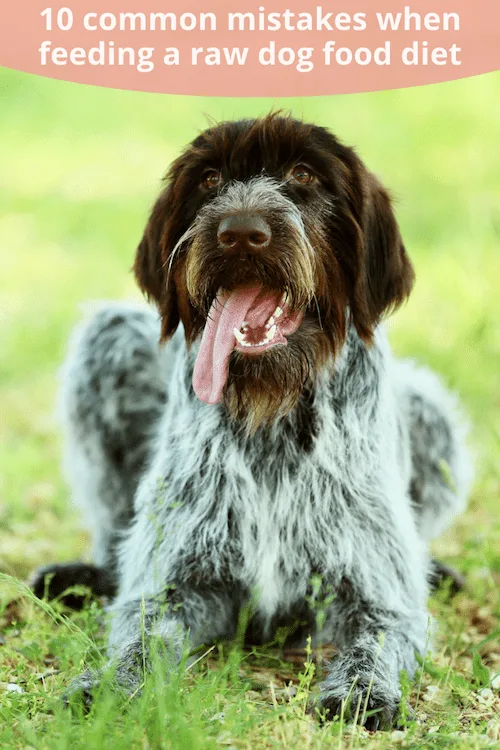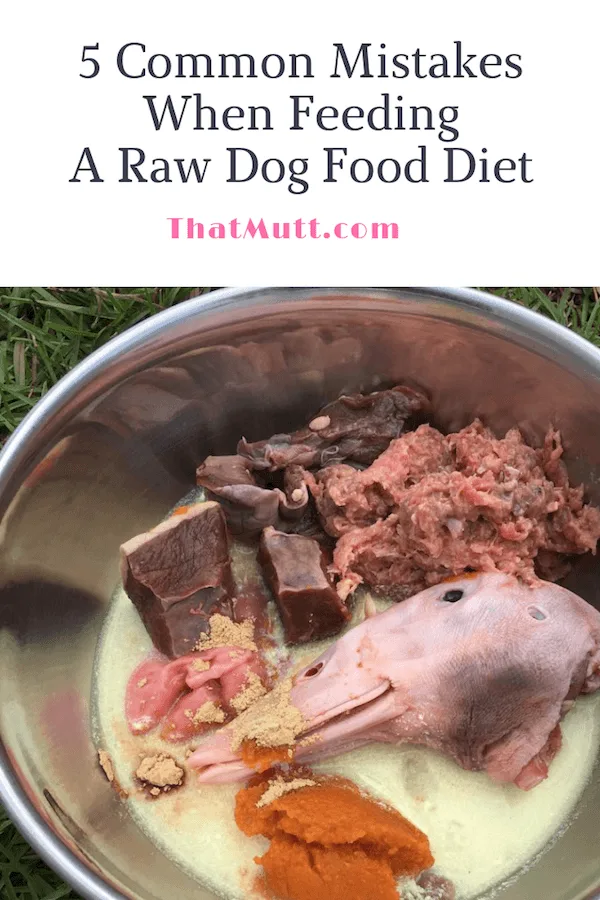As a raw feeder, I know that feeding dogs a raw diet can seem daunting at first.
I remember wondering how I’d make sure my dogs would get all the nutrients they’d need to thrive. Also, how in the world would I figure out how much food they’d need to eat per meal?
There’s really no surprise here as most of us grew up with dogs eating a dry and/or canned food diet. This type of food is entirely prepared for us and only needs to be poured or scooped out into a dog food bowl.
So while there are many lessons to be learned when it comes to feeding and preparing a raw diet, today’s article will set you up on a steeper learning curve since you won’t have to make the mistakes covered!

One of the biggest mistakes in any dog food transitioning phase is introducing too much change too quickly, especially for dogs with sensitive stomachs.
This holds true for switching between different brands of dry or wet dog food, and it’s especially true when making the transition from kibble to fresh food, particularly in dogs who’ve been fed nothing but highly processed dry dog food for many, many years.
Taking it easy is the key, and I’d suggest investing 7-14 days of time to get your dog used to the new raw diet.
I personally transitioned my Boxer mixes Missy & Buzz from their kibble & wet food diet over to a home cooked diet, and then introduced the raw diet over the course of about 2 months. It was a very slow change with an excellent return on my time invested 🙂
10 mistakes when feeding your dog a raw diet
Here are 10 mistakes when feeding your dog a raw diet:
1. Not feeding a balanced raw diet
A huge mistake when feeding dogs a raw meat diet is to feed an unbalanced diet. Some people associate raw feeding with tossing their dog a raw steak before cooking their own, or giving him piles of raw organs such as liver.
While the raw steak can be included in a raw meal from time to time and a little liver is actually a necessary component in raw feeding, a balanced raw diet involves more than just tossing a dog a steak or feeding him piles of organs.
Why is that?
Well, if the dog ate nothing but raw steaks for weeks and months on end, he would be eating an extremely unbalanced diet and suffer from deficiencies due to a lack of nutrient intake.
He would, for example, not get the calcium intake necessary for healthy muscles and bones, which is found in raw meaty bones.
The same goes for eating an abundance of liver – while it’s rich in vitamin A, too much of it causes Vitamin A toxicity and will also cause diarrhea.
On the other end of the spectrum, the absence of Vitamin A can cause blindness, so I believe the importance of balance is starting to come across!
Now in order to be considered a balanced diet, raw meals for dogs need to consist of specific amounts of different cuts of meat.
Recreate a prey animal in a raw diet
Just picture what a prey animal would consist of in its entirety (think rabbit, duck, turkey) and recreate that image in your dog’s food bowl:
- 80% Muscle meat (including fish)
- 10% Raw meaty bones (RMBs)
- 10% Organs (5% liver, 5% other organs such as kidney)
You can also add certain nutrient dense foods as food toppers several times per week. Such foods can be raw eggs including their shell (ideally organic eggs if you’re including the shell) and raw goat milk.
If you’re not adding green tripe to your dog’s meals, you could add some pureed fruits and veggies instead.
The meal in the photo below consists of green tripe (a muscle meat and counts as internal organ because of the digestive enzymes), a turkey neck (raw meaty bone), beef liver (organ) and a whole egg (nutrient dense food that can be added several times per week).

Not every single meal needs to consist of exactly that 80/10/10 ratio. Just make sure to achieve balance over the course of about 7 days, just like you would with your own meals.
I know my own meals don’t consist of every color of the food rainbow every single day, but I make it a point to eat a variety of healthy foods every single week.
You could, for example, feed a raw meaty bone like a chicken leg quarter or a duck frame for breakfast, and then offer a dinner consisting of organs and muscle meat.
Of course, you can also feed a pre-made raw brand where you know the food will be balanced. You can get 10 pounds of food from our partner Darwin’s for just $14.95 and free shipping!
2. Mistaking non-secreting organs for secreting ones
In raw feeding, only secreting organs such as liver, kidney, spleen, pancreas, thymus, brains, and reproductive organs count as organs.
Non-secreting ones like hearts and lungs aren’t considered organs and are to be fed as muscle meat.
That’s definitely confusing at first. I know it was to me, but it was really just a matter of retraining my brain, and now I could tell you in my sleep that hearts aren’t to be fed as organs!
See our post: Organ meat in raw dog food
3. Thawing raw meat in the microwave
Thawing raw meat in the microwave is a huge no-no because it destroys so many nutrients and would defeat the purpose of feeding a nourishing raw meal. Instead, defrost the meat in the fridge. It’s the gentlest way of defrosting.
If you forgot to take meat out of the freezer and are looking at disappointed, hungry doggie eyes, you can cheat a little and defrost the meat in a bowl of cool water. It’ll only take a few hours – been there, done that 😉
*Get our three FREE raw dog food recipes now! Click Here
4. Not feeding enough variety
Dogs should eat from a variety of protein sources because it helps avoid food sensitivities.
The different cuts of meat also contain different minerals and vitamins, all of which are necessary to maintain a healthy body.
Beef, for example, contains more iron and zinc than chicken, but chicken is leaner than beef.
A positive side effect of rotating protein sources is that variety in the food bowl keeps mealtime interesting and your dog looking forward to it. Imagine eating the same exact food every single day of your life.
Not only unhealthy, but also pretty boring, right?
5. Not feeding the right amount
The biggest difference between buying bagged or canned dog food and putting your own raw meals together is that your own meals don’t come with feeding guidelines.
It’s up to us as raw feeders to figure out the right amount of raw food our dogs need on a daily basis to ensure they stay at a healthy weight.
There’s a little math involved with this, but don’t worry, all you need to know are percentages.
You’ll want to feed 2-3% of your adult dog’s ideal body weight per day (for the average dog). The raw feeding formula for puppies up to 12 months of age differs only slightly, and I’ll cover that topic in another blog post soon.
If your dog is overweight, feed a little less, if he’s underweight, feed a little more. Ideally you want to be able to see and feel a nice waistline on your pup.
I’ll give you a few examples of the daily amount to feed:
(16 ounces = 1 pound)
20-pound dog: 2% = 6.4 ounces; 2.5% = 8 ounces; 3% = 9.6 ounces
40-pound dog: 2% = 12.8 ounces; 2.5% = 16 ounces; 3% = 19.2 ounces
60-pound dog: 2% = 19.2 ounces; 2.5% = 14 ounces; 3% = 28.8 ounces
80-pound dog: 2% = 25.6 ounces; 2.5% = 32 ounces; 3% = 38.4 ounces
Remember, these are just examples and every dog is different.
Sometimes the math is easier if you take your dog’s weight in ounces instead of pounds.
To do this, multiply their weight in pounds by 16. Then you can multiple that number by .02 to get 2% of your dog’s body weight in ounces.
Example math for a raw dog food diet:
If the dog is 62 pounds, take 62 X 16 = 992 ounces in body weight.
Two percent of that is 19.84 ounces (992 X .02 = 19.84).
Round up if you want and call it 20 ounces per day.
Remember, 1 pound = 16 ounces.
So in this case, the dog eats 20 ounces per day or 1 pound 4 ounces.
Also note that some dogs may require a lot more food than the average dog. Lindsay’s dog Remy the weimaraner requires about 4% of his body weight per day in raw food because he is active and runs long distances.
If it’s easier, you can also break the food into 3 smaller meals.
*Get our three FREE raw dog food recipes now! Click Here
6. Introducing too many raw foods to your dog at once
It’s really important to feed a variety of different foods. Know that ruminants (beef, sheep, goat) are typically richer in vitamins and minerals than poultry.
Grain-fed beef and domestic poultry are also a lot higher in inflammatory omega-6 fatty acids than they are in anti-inflammatory omega-3 fatty acids.
The ultimate goal should be to feed both white and red meats along with fish to balance out the different fats because fish is high in omega-3 fatty acids.
However, it’s equally important not to introduce too many at once to avoid stomach upset and diarrhea.
Ideally, you’ll want to start by introducing lean white meat like chicken and turkey. Feed muscle meat like breast cuts first, then add bone like wings or feet and secreting organs like liver and kidney.
Offer this for at least one week, or even two to three weeks, depending on how well your dog does with it.
Once your pup does well with the white meat and doesn’t have any loose stools, you can start introducing red meats like beef, pork, lamb venison and goat.

7. Not providing raw bones for your dog to chew
You can start introducing raw bones after your dog’s been on raw food for about 7-10 days. That’s about how long it takes for a dog’s gut to adjust its acidity to a pH level of 2.
It’s important because raw bones digest better in an acidic gut, and the guts of kibble-fed dogs are less acidic than those of their raw-fed friends.
Raw bones are an essential part of a balanced raw diet because they:
- Keep our dogs’ teeth clean and free of tartar buildup. As a result, their breath doesn’t smell. Because of this, they’re also known as Mother Nature’s doggie toothbrush.
- Exercise the dogs’ jaws. Chewing on and eating raw meaty bones is a stimulating exercise for doggie jaws.
- Provide calcium and phosphorus. Both are needed for healthy bones and teeth.
The size of the raw bones that are fed depend on the dog’s size.
Larger dogs are better off eating larger bones like chicken leg quarters or duck frames.
Medium size dogs do well with duck necks and duck or rabbit heads, and small dogs can eat chicken wings or chicken feet and duck feet.
If your dog’s teeth are weak or she’s a senior pup with only a handful of teeth left in her mouth, it’s ok to grind the bone. Another alternative is to feed a pre-made raw diet such as Darwin’s. This diet includes ground raw bones.
However, it’s important to understand that grinding the bone takes away the benefit of clean teeth and jaw exercise.
Read more about raw bones for dogs here.
8. Being overly fearful of bacteria
Handling your dog’s raw meat is no different than preparing your own meat. Wash your hands after handling your dog’s raw meat, and use a common sense cleaning approach overall.
That means washing all surfaces that were in contact with the raw cuts of meat with hot soapy water, and you’ll be just fine. Those surfaces include kitchen counters and cutting boards.
I suggest using plastic cutting boards as opposed to wooden ones because they can go into the dishwasher. Wooden ones would need to be hand-washed which might be less thorough than the dishwasher.
Also wash your dog’s bowl after every raw meal. That’s the easiest way to prevent bacteria buildup. Most bowls can also go into the dishwasher which makes clean-up easy peasy.
Healthy dogs can handle potential bacteria found in raw food because of their acidic stomach environment. If you want additional peace of mind, go ahead and freeze your pup’s raw cuts of meat for 3-4 weeks before feeding them. That’ll get rid of bacteria.
9. Mixing raw dog food with kibble
Most dogs will get an upset stomach when they’re fed raw mixed with kibble. That’s because the two different foods digest at different speeds. Raw food digests faster than kibble.
If you insist on mixing the two, I suggest adding some organic apple cider vinegar because it lowers the pH in your dog’s gut. This helps your dog digest her raw food better since kibble-fed dogs have a less acidic stomach environment than raw-fed dogs.
However, it’s easier for your dog’s digestive system when raw and kibble are fed separately. For example, a raw meal in the morning and kibble at night, or vice versa.
10. Feeding your dog whole veggies/fruit
Dogs lack the enzyme that breaks down plant cell walls. That’s why they can only properly absorb all the nutrients from veggies and fruit when they’ve been puréed, very finely chopped, steamed, or fermented.
When you’re adding plant matter to your dog’s raw diet, keep the amount at 5-10% of his overall meal. Dark leafy greens like kale, broccoli and dandelion greens are particularly valuable because they’re packed with antioxidants.
It’s best to avoid starchy veggies like peas, potatoes, and sweet potatoes because starch makes the pH of the gut more alkaline (as opposed to acidic).
See our article: Do dogs need fruits and veggies?
Have you made any of these raw feeding mistakes?
Do you have any questions about raw feeding?
Let us know in the comments!
Barbara Rivers writes regularly for That Mutt. She is a blogger, raw feeder and former dog walker and maintains the blog K9s Over Coffee.
*Get our three FREE raw dog food recipes now! Click Here
Related articles:
See all of our raw feeding articles HERE.



Susan Beda6rd
Friday 23rd of July 2021
Well I think I'm ready to try raw feeding once again. I was one of the people that found raw food overwhelming difficult. I will try the white meat first ad you suggested.Lulu wasn't always fond of the raw and as she was a 6 month old puppy I didn't press it. U j uj
Claire Bezzina
Sunday 23rd of May 2021
Hi I am trying to transition my one year old pit to a raw food diet as she suffers from a lot of gut issues. Currently she eats mainly human grade home cooked food. I tried to introduce a little raw chicken breast on its own in the morning and she regurgitated it. Is that normal?
Claire Bezzina
Monday 24th of May 2021
@Lindsay Stordahl, thanks so much
Lindsay Stordahl
Monday 24th of May 2021
Yes, some dogs do that, especially if they gulp it down really quickly. Usually not a big deal.
Vanessa Hintalla
Thursday 19th of November 2020
How do you feel about Honest Kitchen dehydrated veggie mix. I’ve been feeding a couple days a week, trying to make sure they get vitamins and minerals..
Lindsay Stordahl
Thursday 19th of November 2020
I think that's a good way to go.
Dawn
Wednesday 18th of November 2020
Hi,
I would love to give my 3 year Black Lab a chicken leg or quarters, but she will a drumstick in 3 bites. Done! I am worried that these bites are too large for her to digest. Any suggestions?
My other dog, Belgian Malinois, takes her time, actually chews it.
Lindsay Stordahl
Thursday 19th of November 2020
As long as she is digesting them, it's probably just fine. You could try feeding them partially frozen to slow her down potentially. I wouldn't feed just the leg as that is pretty small but a quarter or a thigh is probably just fine. My Lab mix and weim also eat a chicken thigh in about three to four bites. No problems.
Rebecca
Tuesday 28th of July 2020
My great dane pit mix wont eat anything but raw meat No veggies fuits kibble canned food nothing no matter how hard I try or what I try how can I get him to eat regular kibble because I cant afford to keep feeding him raw meat please help
Haley
Monday 3rd of August 2020
I would say be stern. Dogs will not starve themselves. Eventually when he is hungry enough he will eat the kibble. I would also suggest to give him raw still after he has eaten the kibble and slowly reduce the portions of raw (do this after he’s eaten kibble though, if you do it before he might not eat the kibble still). I did just the opposite with my super picky Great Dane, he hates kibble too and he’s underweight because I can’t get him to eat enough. He’s been quite enjoying the raw now though! So I do caution you though as well, because my Dane hated kibble he just wouldn’t eat much, and it made him underweight.